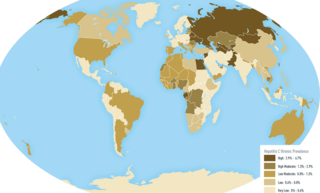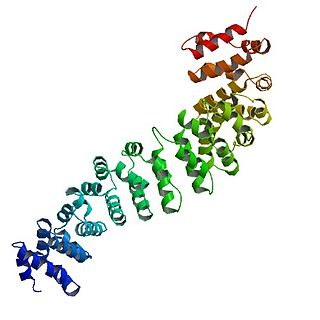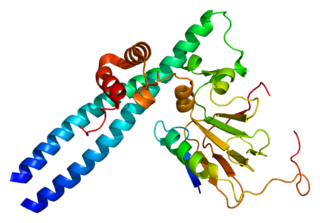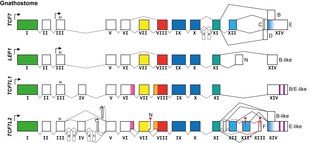Related Research Articles

Papillomaviridae is a family of non-enveloped DNA viruses whose members are known as papillomaviruses. Several hundred species of papillomaviruses, traditionally referred to as "types", have been identified infecting all carefully inspected mammals, but also other vertebrates such as birds, snakes, turtles and fish. Infection by most papillomavirus types, depending on the type, is either asymptomatic or causes small benign tumors, known as papillomas or warts. Papillomas caused by some types, however, such as human papillomaviruses 16 and 18, carry a risk of becoming cancerous.

An oncovirus or oncogenic virus is a virus that can cause cancer. This term originated from studies of acutely transforming retroviruses in the 1950–60s, when the term "oncornaviruses" was used to denote their RNA virus origin. With the letters "RNA" removed, it now refers to any virus with a DNA or RNA genome causing cancer and is synonymous with "tumor virus" or "cancer virus". The vast majority of human and animal viruses do not cause cancer, probably because of longstanding co-evolution between the virus and its host. Oncoviruses have been important not only in epidemiology, but also in investigations of cell cycle control mechanisms such as the retinoblastoma protein.
E2F is a group of genes that encodes a family of transcription factors (TF) in higher eukaryotes. Three of them are activators: E2F1, 2 and E2F3a. Six others act as suppressors: E2F3b, E2F4-8. All of them are involved in the cell cycle regulation and synthesis of DNA in mammalian cells. E2Fs as TFs bind to the TTTCCCGC consensus binding site in the target promoter sequence.

Catenin beta-1, also known as beta-catenin (β-catenin), is a protein that in humans is encoded by the CTNNB1 gene.

Cyclin D is a member of the cyclin protein family that is involved in regulating cell cycle progression. The synthesis of cyclin D is initiated during G1 and drives the G1/S phase transition. Cyclin D protein is anywhere from 155 to 477 amino acids in length.

Histone deacetylase 1 (HDAC1) is an enzyme that in humans is encoded by the HDAC1 gene.

Transcription factor E2F1 is a protein that in humans is encoded by the E2F1 gene.

Retinoblastoma-like protein 2 is a protein that in humans is encoded by the RBL2 gene.

Transcription factor E2F3 is a protein that in humans is encoded by the E2F3 gene.

Transcription factor E2F2 is a protein that in humans is encoded by the E2F2 gene.

Transcription factor PU.1 is a protein that in humans is encoded by the SPI1 gene.

Retinoblastoma-like 1 (p107), also known as RBL1, is a protein that in humans is encoded by the RBL1 gene.

HMG-box transcription factor 1, also known as HBP1, is a human protein.

Lysine-specific demethylase 5A is an enzyme that in humans is encoded by the KDM5A gene.

AT rich interactive domain 4A (RBP1-like), also known as ARID4A, is a protein which in humans is encoded by the ARID4A gene.

EP300-interacting inhibitor of differentiation 1 is a protein that in humans is encoded by the EID1 gene.

The TCF/LEF family is a group of genes that encode transcription factors which bind to DNA through a SOX-like high mobility group domain. They are involved in the Wnt signaling pathway, particularly during embryonic and stem-cell development, but also had been found to play a role in cancer and diabetes. TCF/LEF factors recruit the coactivator beta-catenin to enhancer elements of genes they target. They can also recruit members of the Groucho family of corepressors.

The retinoblastoma protein is a tumor suppressor protein that is dysfunctional in several major cancers. One function of pRb is to prevent excessive cell growth by inhibiting cell cycle progression until a cell is ready to divide. When the cell is ready to divide, pRb is phosphorylated, inactivating it, and the cell cycle is allowed to progress. It is also a recruiter of several chromatin remodeling enzymes such as methylases and acetylases.
Ed Harlow is an American molecular biologist.
Peter Maxwell Howley is an American pathologist, virologist, and professor at Harvard Medical School. He has been president of the American Society for Virology and the American Society for Investigative Pathology and a co-editor of the Annual Review of Pathology: Mechanisms of Disease.
References
- ↑ "Dyson Lab - Massachusetts General Hospital, Boston, MA". www.massgeneral.org. Massachusetts General Hospital.
- ↑ Dyson, N; Howley, PM; Munger, K; Harlow, E (1989). "The human papilloma virus-16 E7 oncoprotein is able to bind to the retinoblastoma gene product". Science. 243 (4893): 934–7. Bibcode:1989Sci...243..934D. doi:10.1126/science.2537532. PMID 2537532.
- ↑ Morris, E; Ji, J; Yang, F; Di Stefano, L; Herr, A; Moon, N; Kwon, E; Haigis, K; Naar, A; Dyson, N (2008). "E2F1 represses beta-catenin transcription and is antagonized by both pRB and CDK8". Nature. 455 (7212): 552–6. Bibcode:2008Natur.455..552M. doi:10.1038/nature07310. PMC 3148807 . PMID 18794899.